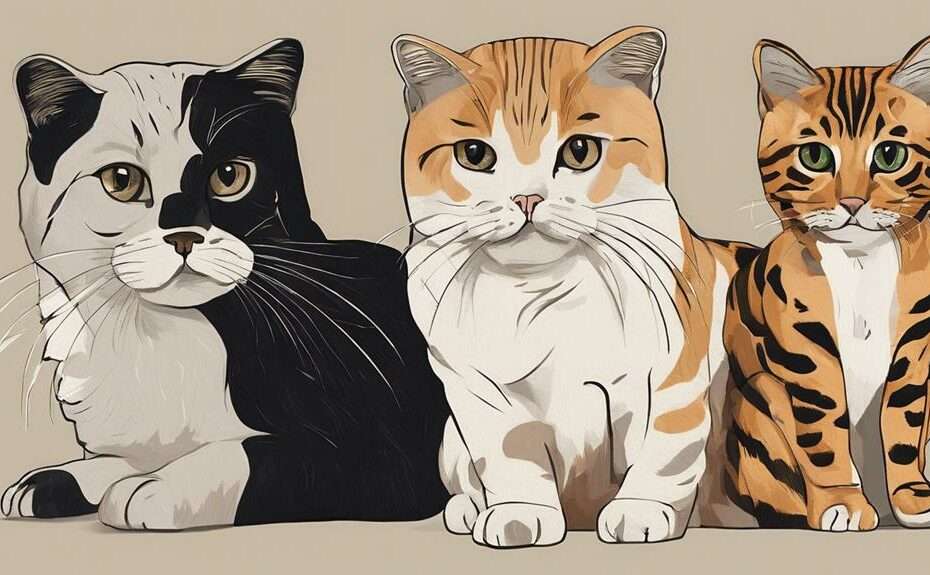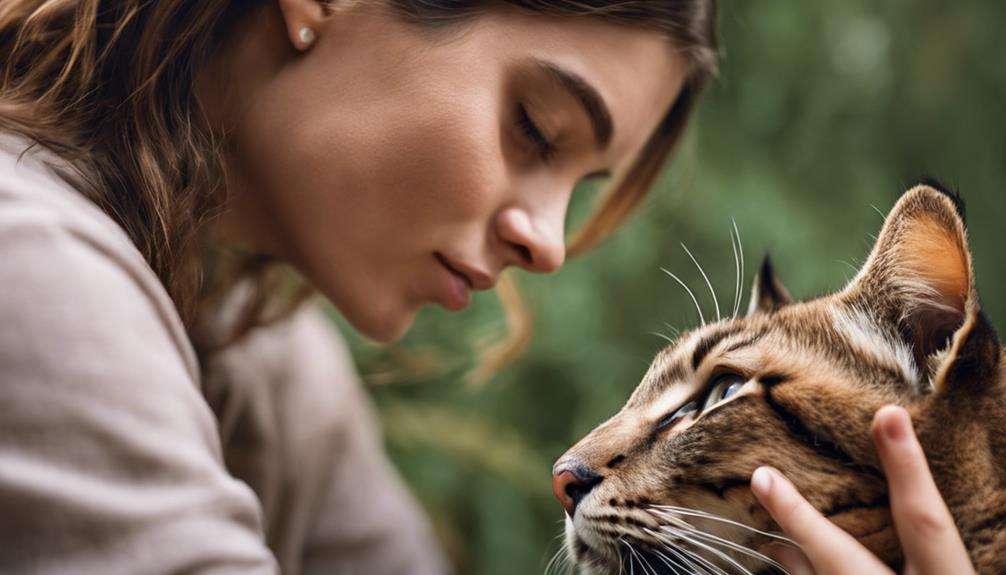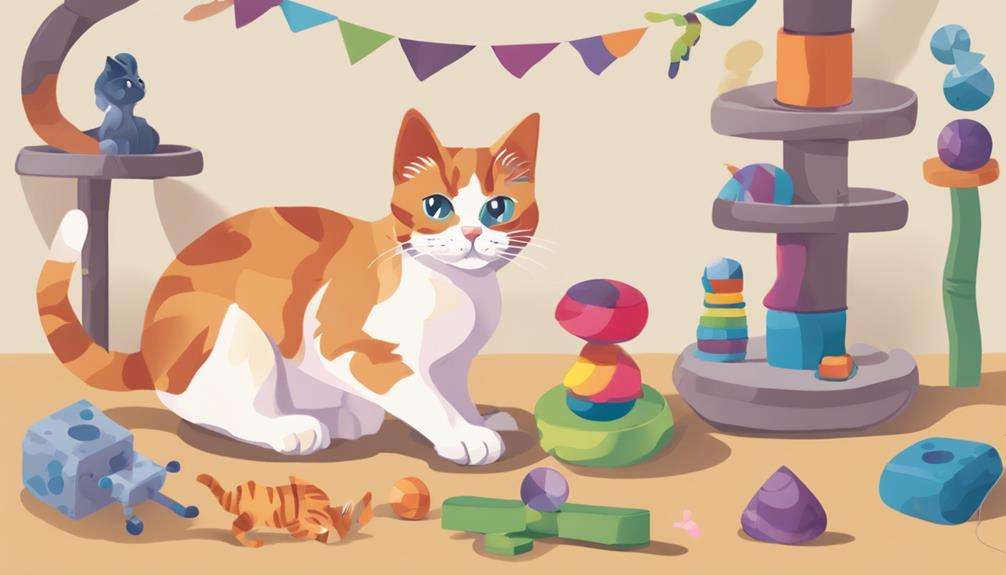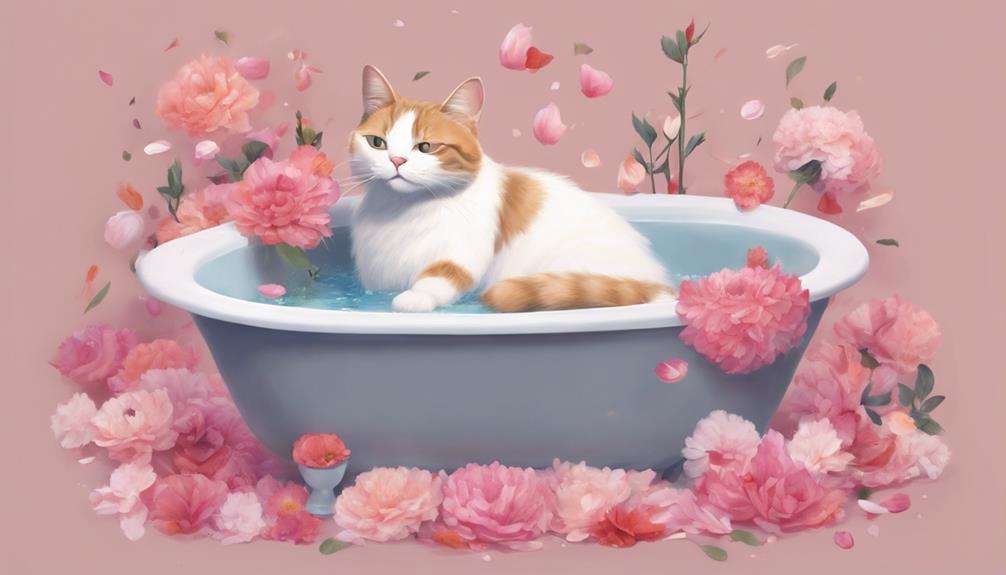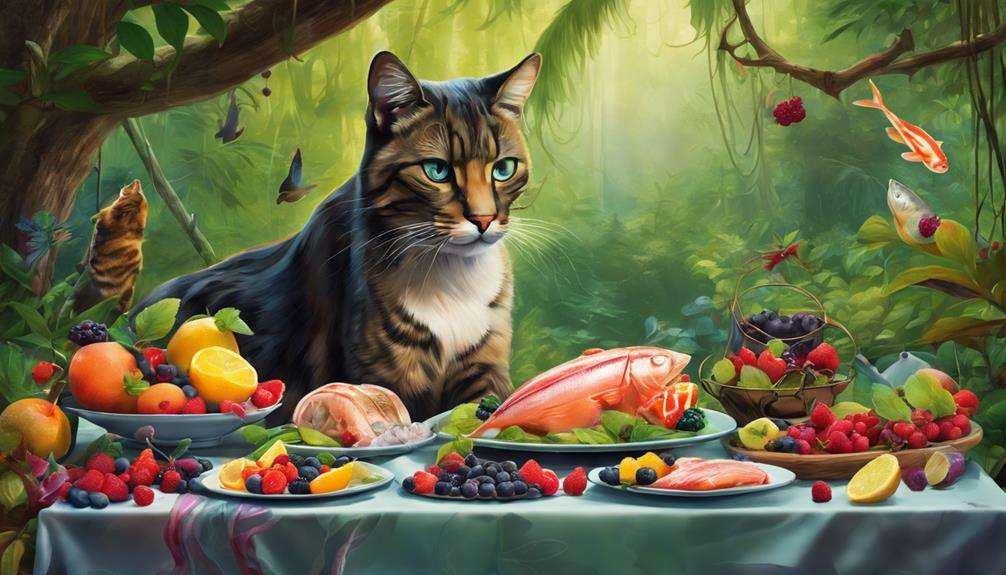Ever heard the saying, 'Curiosity killed the cat'? Well, when it comes to feline species, curiosity is just one of the many intriguing traits that define these captivating creatures. Imagine a world where each cat breed possesses its own set of remarkable characteristics that set them apart from the rest.
From sleek coats to playful temperaments, there's a whole universe of distinct feline species traits waiting to be explored, each more fascinating than the last. What makes these feline friends so unique? Let's uncover the secrets behind seven of the best distinctive traits that make them stand out from the crowd.
Key Takeaways
- Ocicat's exotic charm is showcased in its sleek, wild lineage coat patterns.
- Selkirk Rex's whimsical curly coat and grooming needs set it apart.
- Minskin's small size and big personality make it a popular distinctive choice.
- Peterbald's rarity and elegant hairless appearance define its unique feline traits.
Ocicat's Wild-Like Appearance
The Ocicat's wild-like appearance intricately mirrors its ancestral feline lineage, embodying a captivating blend of domesticity and untamed allure. This breed's unique coat is a key feature that sets it apart from other domestic cats. The Ocicat's coat showcases striking feral-esque patterns reminiscent of a wild ocelot, with spots and markings that pay homage to its wild heritage. These distinctive coat markings not only add to the Ocicat's exotic charm but also contribute to its overall allure.
The unique coat of the Ocicat isn't just visually appealing but also serves as a testament to the breed's fascinating genetic history. The combination of wild-like patterns and domestic characteristics creates a captivating aesthetic that appeals to those seeking a feline companion with a touch of the wild. Additionally, the sleek and athletic build of the Ocicat complements its unique coat, enhancing its overall appearance and aura of strength and confidence.
Selkirk Rex's Signature Curly Coat
The Selkirk Rex's signature curly coat is a fascinating genetic trait that distinguishes this breed from others. The unique texture of their fur, ranging from loose waves to tight ringlets, is a result of a natural mutation.
To maintain the health and appearance of their curly coat, regular grooming and attention to their specific needs are essential.
Unique Coat Texture
Displaying a distinctive genetic mutation, the Selkirk Rex boasts a signature curly coat that sets it apart from other feline species. This breed's curly coat is a defining feature, ranging from tight curls to loose waves, contributing to its fluffy appearance.
The Selkirk Rex's plush and velvety coat isn't only visually appealing but also pleasant to touch, often likened to the softness of lamb's wool. To maintain the luxurious texture of the curly coat, regular grooming is essential to prevent matting.
Additionally, unlike many other cat breeds, the Selkirk Rex's coat sheds minimally, making it an excellent choice for individuals with allergies. The unique curly texture of the Selkirk Rex's coat adds to its charm and appeal, making it a standout among feline species.
Genetic Curly Trait
How does the Selkirk Rex's genetic mutation result in its signature curly coat texture?
The Selkirk Rex's curly coat is a distinctive feature resulting from a dominant gene that causes the hair follicles to be oval-shaped rather than round. This genetic mutation leads to the production of unique hair shafts that are predisposed to bending, creating the characteristic curls seen in this breed.
The curly coat of the Selkirk Rex is soft and plush, varying in curl tightness from loose waves to tight ringlets. Unlike many other cat breeds, Selkirk Rex kittens are born with their curly coats, highlighting the early onset of this genetic trait.
The charming and whimsical appearance of Selkirk Rex cats is largely attributed to their curly fur, setting them apart in the feline world.
Maintenance Tips
Selkirk Rex's distinctive curly coat requires specific maintenance techniques to preserve its unique texture and prevent matting and tangles. Regular grooming is crucial to prevent matting and tangles in the curly fur. Here are some tips for maintaining a Selkirk Rex's curly coat:
- Use a wide-toothed comb or a slicker brush to gently untangle the curls.
- Bathe the Selkirk Rex occasionally to keep the curly coat clean and free from excess oils.
- Seek advice from a veterinarian or professional groomer for tailored care tips.
- Regularly check for any signs of matting or knots in the curly coat to address them promptly.
Sphynx's Uniquely Hairless Body
The Sphynx cat's hairless body is a result of a genetic mutation that affects their fur growth, making them unique among feline breeds. Their lack of fur gives them a distinctive feel, with a fine layer of downy fuzz providing a soft and velvety texture.
This hairless trait not only sets them apart aesthetically but also grants them advantages in temperature regulation and potential hypoallergenic qualities compared to other cats.
Hairless and Hypoallergenic
Sphynx cats, renowned for their hairless bodies covered in a soft peach-like skin, exhibit unique traits that set them apart from other feline species. These cats aren't hypoallergenic, but their minimal shedding makes them easier for some individuals with cat allergies to tolerate.
Due to their lack of fur, Sphynx cats require regular bathing to remove excess oils that would typically be absorbed by fur. Although they lack a traditional coat, some Sphynx cats may have fine, downy hairs on their body, providing them with a velvety texture.
- Sphynx cats aren't hypoallergenic.
- Regular bathing is necessary to remove excess oils due to their hairlessness.
- Sphynx cats may have fine, downy hairs on their body.
- Minimal shedding makes them easier for some individuals with cat allergies to tolerate.
Temperature Regulation Advantage
With their unique hairless bodies, Sphynx cats possess a distinct advantage in regulating their body temperature compared to other feline species. Unlike Siamese cats or other breeds with fur coats, the Sphynx's lack of fur allows for more efficient dissipation of heat. This characteristic helps them stay cool in warm environments and prevents overheating.
To compensate for the absence of insulating fur, Sphynx cats have a higher metabolic rate, aiding in heat production and regulation. The Sphynx's distinctive appearance not only makes them sought after as pets but also highlights their exceptional temperature-regulating abilities.
Their hairlessness serves as a natural advantage, showcasing how evolutionary adaptations can provide felines with unique physiological benefits.
Minskin's Tiny Stature and Playful Nature
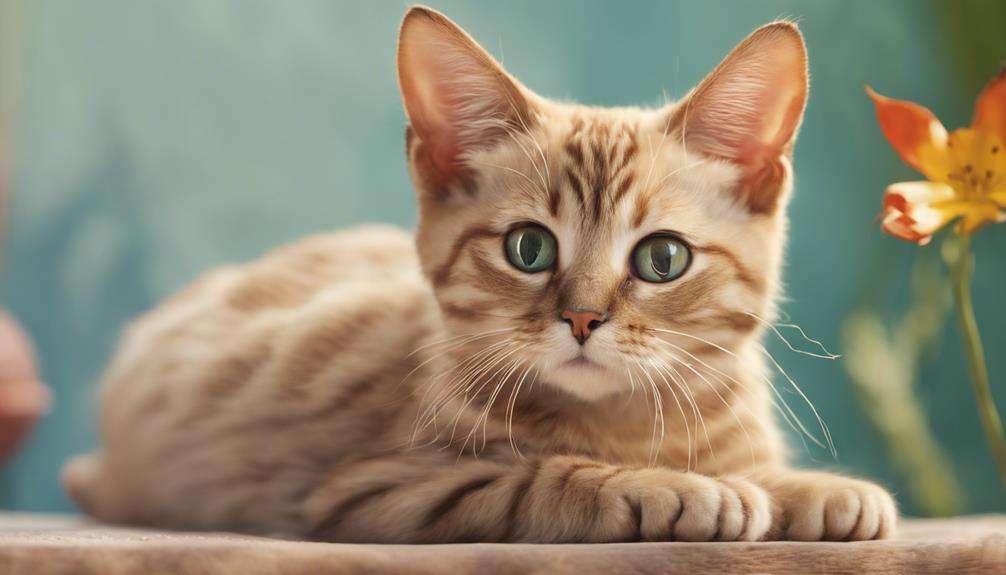
Incorporating a distinctive blend of short legs and a diminutive stature, the Minskin breed epitomizes a unique feline crossroads, reminiscent of a dachshund within the realm of cats. Minskins are known for their small size but big personalities, making them a delightful addition to any household.
Here are some key traits that make the Minskin breed stand out:
- Unique Physical Appearance: The Minskin's short legs and small body give them a distinct appearance that sets them apart from other cat breeds.
- Playful Nature: Despite their tiny stature, Minskins are energetic and love engaging in interactive play with their human companions.
- Friendly Disposition: Minskins are social butterflies, enjoying the company of both humans and other pets. Their outgoing and affectionate personalities make them ideal lap cats.
- Popular Choice: The Minskin's combination of unique looks and friendly nature has made them a popular choice for those seeking a loving and distinctive feline companion.
Singapura's Small Size but Big Personality
Singapura cats, renowned for their diminutive size yet vibrant personalities, captivate with their engaging demeanor and distinctive physical features. Despite their small size, typically ranging from 4-8 pounds, Singapuras possess large ears and expressive eyes that contribute to their charming appearance. This breed's small stature doesn't limit its presence; in fact, their petite build enhances their agility and nimbleness, allowing them to navigate spaces with grace and ease.
Their small size is complemented by their big personality – Singapuras are highly interactive and thrive on human companionship. Their affectionate and social nature makes them ideal companions for those seeking a feline friend who enjoys engaging with people. Despite their tiny frame, Singapuras are known for their frisky and inquisitive personalities, constantly exploring their environment with curiosity and enthusiasm.
Napoleon's Folded Ears and Short Legs
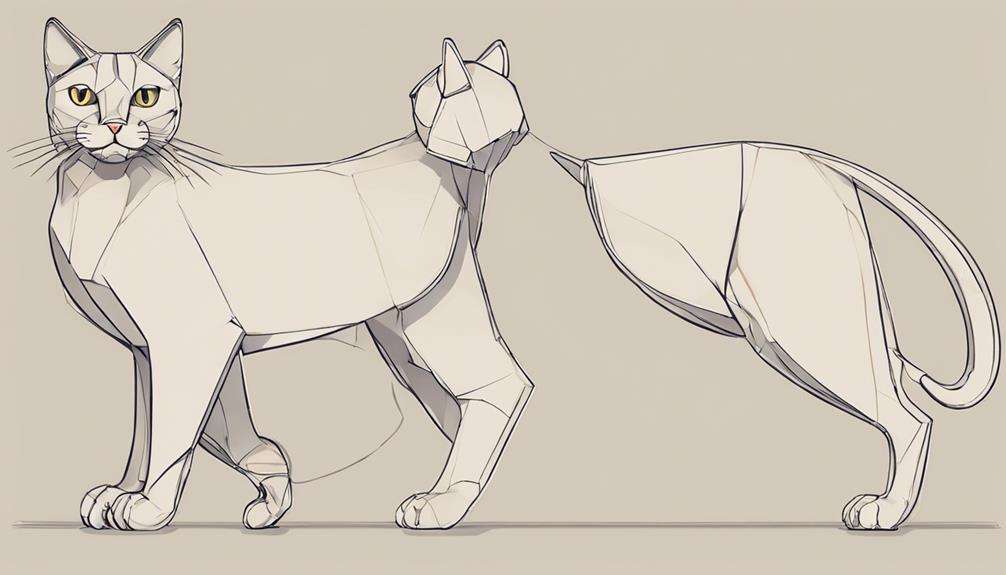
Napoleon cats exhibit a distinctive appearance characterized by their folded ears and short legs, setting them apart in the world of feline breeds. These unique physical traits contribute to their charm and appeal among cat enthusiasts.
- Napoleon cats are recognized for their folded ears, a feature that adds to their adorable look.
- The short legs of Napoleon cats are a result of their Munchkin lineage, giving them a distinct appearance.
- Despite their short legs, Napoleon cats remain agile and playful, enjoying interactive playtime with their human companions.
- The combination of folded ears and short legs in Napoleon cats creates a captivating visual aesthetic, making them stand out in the feline world.
Napoleon cats' folded ears and short legs not only make them visually striking but also enhance their friendly and social nature. These physical characteristics contribute to their overall charm and appeal, making them a sought-after breed for those looking for a unique and affectionate feline companion.
Peterbald's Elegant and Hairless Body
The Peterbald cat breed boasts an elegant and distinctive hairless or short peach fuzz-like coat, setting it apart as a rare and graceful feline species. Originating in Russia, the Peterbald's unique hairless coat is a result of genetic mutations. This breed is among the rarest due to the limited number of breeders specializing in maintaining its hairless trait.
The absence of fur gives the Peterbald a sleek and smooth appearance, enhancing its graceful silhouette. Despite their lack of a traditional coat, Peterbald cats aren't entirely hairless; they may have a fine layer of downy hair, giving them a soft velvety feel. This thin layer of fuzz is a defining feature of the breed and distinguishes it from completely hairless breeds like the Sphynx.
The Peterbald's elegant body, combined with its affectionate and social nature, makes it a unique and captivating companion for those looking for a distinctive feline friend.
Frequently Asked Questions
What Are the Top Feline Personality Traits?
When it comes to feline personality traits, cats exhibit a wide range of behaviors. Understanding their playful purrsonality involves recognizing neuroticism, extraversion, dominance, impulsiveness, and agreeableness. Each cat's unique blend shapes their individuality.
What Are the Distinct Characteristics of a Cat?
When it comes to feline behavior, understanding the distinct characteristics of a cat is crucial. Factors like genetics and early experiences shape a cat's personality. Different breeds showcase unique physical and behavioral traits, from adventurous playfulness to gentle relaxation.
What Are the Unique Characteristics of Felidae?
Feline communication is multifaceted, encompassing vocalizations, body language, and scent marking. Cats use meows, purrs, hisses, and more to convey emotions and needs. Understanding these signals is crucial for interpreting your feline companion's feelings.
What Is the Most Unique Type of Cat?
You'll find fascination in the Lykoi cat's wolf-like allure. Its sparse fur and haunting appearance make it a standout. Among feline adaptations, the Lykoi's resemblance to a wolf sets it apart as one of the most unique feline species.
Conclusion
In conclusion, the feline world is a fascinating realm of diversity and uniqueness, with each breed showcasing distinctive traits that capture the hearts of cat lovers worldwide.
From the wild-like appearance of the Ocicat to the signature curly coat of the Selkirk Rex, each breed offers a one-of-a-kind charm that sets them apart.
These feline species traits, from hairless bodies to tiny statures and playful personalities, truly make each cat breed a marvel of nature.
